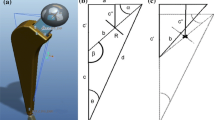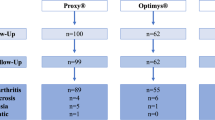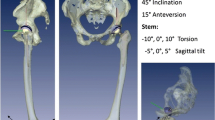Abstract
Adequate stem alignment is essential for the success of Total Hip Arthroplasty (THA) to avoid dislocation and impingement. One factor that has not been sufficiently investigated so far is the stem tilting in the sagittal plane, which has an influence on the position of the centre of the femoral head and thus also on prosthesis torsion. We aimed to evaluate sagittal stem position using 3D-CTs in patients with THA and to develop a mathematical-geometrical model to simulate the functional correlation between sagittal stem tilting and the influence on functional anteversion. Thirty patients with THA underwent a CT-scan. By 3D-reconstruction of the CT-data, femoral-/prosthesis-axis, torsion and sagittal tilt were determined. In accordance with the position of the femoral and prosthesis axes, the rotatory (rAV) (surgically adjusted) and functional (depending on sagittal tilt) anteversion (fAV) was measured. A three dimentional-coordinate transformation was also performed using the Euler-angles to derive a mathematical-geometrical correlation between sagittal stem tilting and corresponding influence on anteversion. The mean rAV was 8° (-11.6 - 26°), the fAV 18° (6.2 - 37°), and the difference 10° (8.8 - 18°). The mean degree of stem tilting was 5.2° (0.7 - 9°) anterior towards the femoral axis. The individually measured parameters are reflected in the mathematical-geometrical model. Depending on the extent of the sagittal deviation, a clear influence on the torsion emerges. For example, a stem implanted at a 15° anteverted angle with a sagittal tilt by two degrees towards anterior results in a fAV of 20°. A clear association between the sagittal stem alignment and the impact on the fAV was demonstrated. Hence, the rotatory anteversion intended by the surgeon may be functionally significantly different. This might pose an increased risk of dislocation or impingement. The sagittal tilt of the prosthesis should therefore be considered in the context of impingement and dislocation diagnosis. In this respect, we recommend a 3D-analysis of stem alignment.





Similar content being viewed by others
References
Bicanic G, Delimar D, Delimar M, Pecina M (2009) Influence of the acetabular cup position on hip load during arthroplasty in hip dysplasia. Int Orthop 33(2):397–402
Cinotti G, Lucioli N, Malagoli A, Calderoli C, Cassese F (2010) Do large femoral heads reduce the risks of impingement in total hip arthroplasty with optimal and non-optimal cup positioning? Int Orthop [Epub ahead of print]
D’Lima DD, Urquhart AG, Buehler KO, Walker RH, Colwell CW Jr (2000) The effect of the orientation of the acetabular and femoral components on the range of motion of the hip at different head-neck ratios. J Bone Joint Surg Am 82(3):315–321
Dorr LD, Malik A, Dastane M, Wan Z (2009) Combined anteversion technique for total hip arthroplasty. Clin Orthop Relat Res 467(1):119–127
Dorr LD, Wan Z (1998) Causes of and treatment protocol for instability of total hip replacement. Clin Orthop Relat Res 355:144–151
Earll M, Fehring T, Griffin WL, Mason JB, McCoy TH (2004) Early osteolysis associated with trunion-liner impingement. Clin Orthop Relat Res 418:153–156
Enocson A, Lapidus G, Tornkvist H, Tidermark J, Lapidus LJ (2010) Direction of hip arthroplasty dislocation in patients with femoral neck fractures. Int Orthop [Epub ahead of print]
Gallo J, Havranek V, Zapletalova J (2010) Risk factors for accelerated polyethylene wear and osteolysis in ABG I total hip arthroplasty. Int Orthop 34(1):19–26
Jolles BM, Zangger P, Leyvraz PF (2002) Factors predisposing to dislocation after primary total hip arthroplasty: a multivariate analysis. J Arthroplasty 17(3):282–288
Maruyama M, Feinberg JR, Capello WN, D’Antonio JA (2001) The Frank Stinchfield Award: morphologic features of the acetabulum and femur: anteversion angle and implant positioning. Clin Orthop Relat Res 393:52–65
Ranawat C, Maynard M (1991) Modern techniques of cemented total hip arthroplasty. Tech Orthop 6:17–25
Widmer KH, Zurfluh B (2004) Compliant positioning of total hip components for optimal range of motion. J Orthop Res 22(4):815–821
Ybinger T, Kumpan W (2007) Enhanced acetabular component positioning through computer-assisted navigation. Int Orthop 31(Suppl 1):S35–S38
Acknowledgment
We acknowledge and thank Dr. rer. nat. Bernd Müller from the Institute of Physical Chemistry of the Friedrich Schiller University Jena for the mathematical support and instruction.
Conflict of interest statement
The authors have no conflict of interest to report. No specific funding was received.
Author information
Authors and Affiliations
Corresponding author
Rights and permissions
About this article
Cite this article
Müller, M., Crucius, D., Perka, C. et al. The association between the sagittal femoral stem alignment and the resulting femoral head centre in total hip arthroplasty. International Orthopaedics (SICOT) 35, 981–987 (2011). https://doi.org/10.1007/s00264-010-1047-z
Received:
Revised:
Accepted:
Published:
Issue Date:
DOI: https://doi.org/10.1007/s00264-010-1047-z




